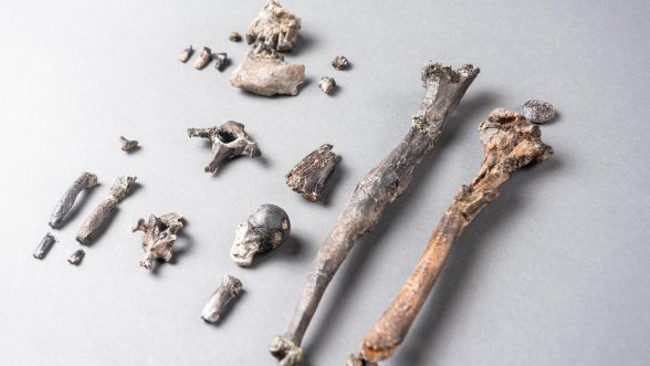The discovery reveals a possible common ancestor of humans and great apes, write Madelaine Böhme from Eberhard-Karls University in Tübingen, Germany, and colleagues in the journal Nature.
It also contests theories about how hominin bipedalism evolved, they suggest. "Ever since Darwin, the early evolution of humans and our cousins, the great apes, has been intensely debated," says Böhme.
How humans came to walk on two legs is central to these debates, she adds, and several ideas have been put forward over the past 150 years.
These include notions that bipedal humans evolved from tree-dwelling, monkey-like apes that moved on all fours, from tree-swinging apes similar to orangutans, or from knuckle-walking apes like chimpanzees and gorillas.
Fossil evidence to support these theoretical models has so far been weak, and the new fossils from the mid to late Miocene, discovered in the Allgäu region of Bavaria in Germany, suggest that none is correct.
The researchers excavated more than 15,000 fossil vertebrate bones from the ancient humid, forested ecosystems that characterised Germany at that time. These included the remains of at least four individual hominids: one male, two females and one juvenile.
The male Danuvius had the most complete skeleton, with proportions similar to modern-day bonobos, including fully preserved limb bones, vertebra, finger and toe bones that enabled the researchers to reconstruct the way it moved about.
"Importantly, for the first time, we were able to investigate several functionally important joints, including the elbow, wrist, hip, knee and ankle, in a single fossil of this age," Böhme says.
"And it was astonishing for us to realise how similar certain bones are to humans, as opposed to great apes."
What they discovered was evidence of both tree-swinging and walking, a new type of positional behaviour the authors termed "extended limb clambering" that combines the bipedal and suspensory adaptations of hominids in roughly equal proportions.
The forearm was long, relative to the leg, and the flexible elbow and hand bones suggest a strong, grasping thumb and curved fingers typical of great apes that hang from trees.
The legs were more similar to humans; the shape of the hip and knee joints indicated upright postures, unlike the bent hips and knees of living African apes who sometimes walk on two feet in the trees or on the ground.
Stable ankle joints and a reinforced lower leg bone also imply bipedalism. A long big toe could have been used for grasping, indicating D. guggenmosi walked on tree branches.
Böhme says it suggests that apes started walking on their hind legs before they came down from the trees, and that the evolutionary process occurred in Europe during the Middle Miocene.
Comment: So much for the "out of Africa" theory.
In a related "News and views" article, Tracy Kivell, from the University of Kent in the UK, agrees the discovery offers a plausible model for how the last common ancestor of hominids and hominins moved around.
Kivell says the new fossils are exciting, and their preservation and morphology are impressive - particularly the virtually complete long bones from the forearm and the leg, which is unusual for the Miocene.
She thinks Böhme and colleagues make a good case for extended-limb bipedalism.
"The Miocene is known for its strange mixes of monkey-like and ape-like features that are found in combinations that we often don't see in any living primate," she says. "Therefore, it's always a bit of a puzzle to figure out how these fossil creatures might have moved around."
Kivell says the shapes of the Danuvius hip and knee joints do indicate more extended limb postures than seen in living great apes, and the ankle joint suggests stability, which is needed for walking on two feet.
She adds that the kind of movements evidenced by the fossils "could provide the 'right mix' of suspension/climbing and bipedalism in the trees that would make a good model for what hominin bipedalism evolved from."
"Given that all living apes use bipedalism to some degree - often in the trees, but also on the ground - it is not unreasonable to suggest that bipedalism evolved much earlier in hominoid evolution than we previously thought.
"When it helps to free up the hands, bipedalism can be a pretty useful way of getting around."




Reader Comments